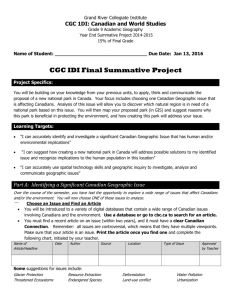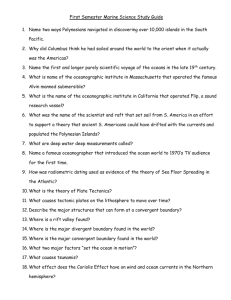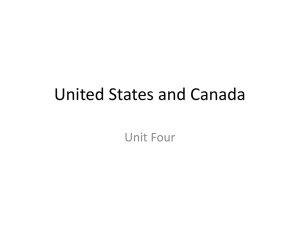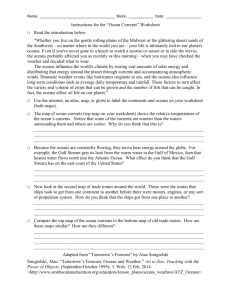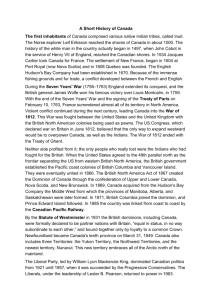Ocean Currents and Meteorology - Canadian Geographic Education
advertisement
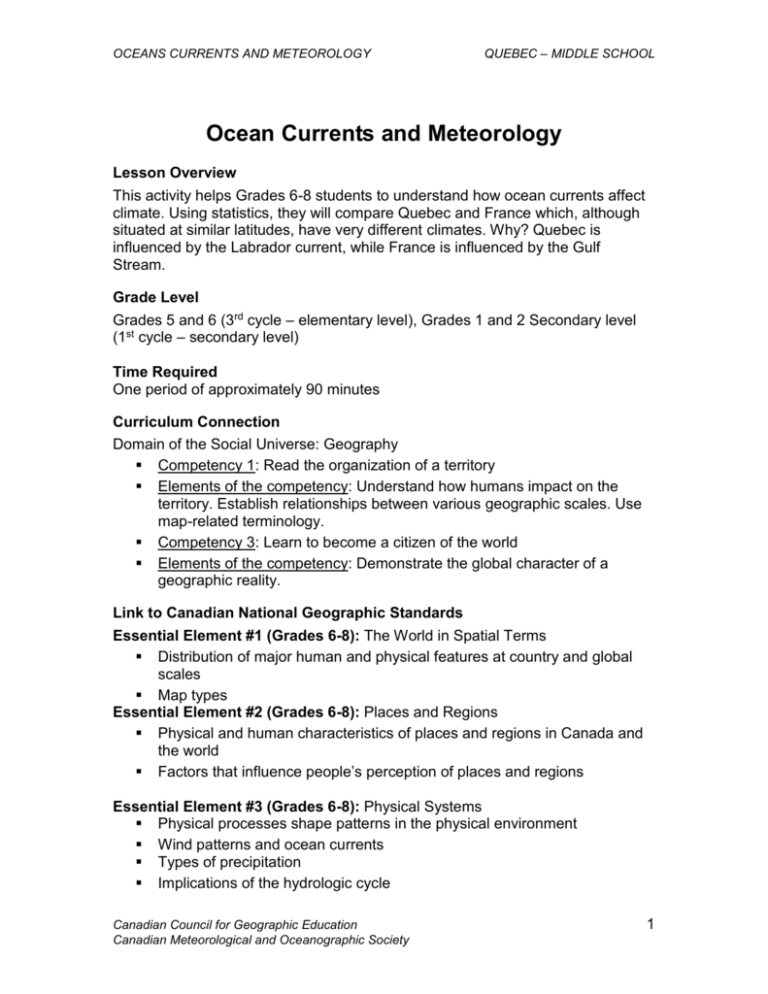
OCEANS CURRENTS AND METEOROLOGY QUEBEC – MIDDLE SCHOOL Ocean Currents and Meteorology Lesson Overview This activity helps Grades 6-8 students to understand how ocean currents affect climate. Using statistics, they will compare Quebec and France which, although situated at similar latitudes, have very different climates. Why? Quebec is influenced by the Labrador current, while France is influenced by the Gulf Stream. Grade Level Grades 5 and 6 (3rd cycle – elementary level), Grades 1 and 2 Secondary level (1st cycle – secondary level) Time Required One period of approximately 90 minutes Curriculum Connection Domain of the Social Universe: Geography Competency 1: Read the organization of a territory Elements of the competency: Understand how humans impact on the territory. Establish relationships between various geographic scales. Use map-related terminology. Competency 3: Learn to become a citizen of the world Elements of the competency: Demonstrate the global character of a geographic reality. Link to Canadian National Geographic Standards Essential Element #1 (Grades 6-8): The World in Spatial Terms Distribution of major human and physical features at country and global scales Map types Essential Element #2 (Grades 6-8): Places and Regions Physical and human characteristics of places and regions in Canada and the world Factors that influence people’s perception of places and regions Essential Element #3 (Grades 6-8): Physical Systems Physical processes shape patterns in the physical environment Wind patterns and ocean currents Types of precipitation Implications of the hydrologic cycle Canadian Council for Geographic Education Canadian Meteorological and Oceanographic Society 1 OCEANS CURRENTS AND METEOROLOGY QUEBEC – MIDDLE SCHOOL Causes and patterns of extreme natural events Essential Element #6 (Grades 6-8): Environment and Society Impact of natural and technological hazards/disasters on the human and physical environment Limits and opportunities of the physical environment for human activities Geographic Skill #1 (Grades 6-8): Asking Geographic Questions Plan how to answer geographic questions Geographic Skill #2 (Grades 6-8): Acquiring geographic information Use maps to collect and/or compile geographic information Geographic Skill #4 (Grades 6-8): Analyzing Geographic Information Interpret information obtained from maps Interpret information obtained from a variety of sources Geographic Skill #1 (Grades 6-8): Answering Geographic Questions Develop and present combinations of geographic information to answer geographic questions Curriculum Connection Learning outcome: Understand geographic relationships, using a map of the world Skills - Use geographic tools - Interpret different forms of representations - Interpret graphs - Use accurate geographic terms Additional Resources, Materials and Equipment Required The Atlas of Canada: Map of Canada (The world) Useful websites to help students learn more about ocean currents http://www.heritage.nf.ca/environment/ocean.html http://www.cnes.fr/html/_98_3112_3147_3463_3464_.php http://www.wonderquest.com/GulfStream.htm and the following page of links: http://www.bigelow.org/vendeeglobe/Gulf%20Stream.htm Canadian Council for Geographic Education Canadian Meteorological and Oceanographic Society 2 OCEANS CURRENTS AND METEOROLOGY QUEBEC – MIDDLE SCHOOL Main Objective To explain how the ocean currents influence the physical environment (climate) in Quebec and in France. Learning Outcomes By the end of the lesson, students will be able to: Identify the ocean currents that affect Quebec and France Know the specific characteristics of each of the climates in the two regions studied The Lesson Conclusion Lesson Development Introduction Teacher Activity Student Activity Ask students to study the oceans on a map of the world. Invite students to tell what they know about oceans. Ask students to form groups of two. Study the map. Revise previous knowledge of oceans. Find a fellow student to work with. Divide the teams into two working groups, with one group working on Activity Sheet A and the other on Activity Sheet B. Hand out the Activity Sheets and ask students to complete the required tasks. Allow some time to do the work. Then have students share what they have discovered about each of the regions studied. List the characteristics of the Labrador current and the Gulf Steam. Follow instructions. With partner, read carefully the questions on the Activity Sheet. Become aware of the important differences between the Quebec climate and that of France, despite the fact that both are situated at similar latitudes. Verify if their knowledge on the subject was correct, when answering the last question. Reformulate the initial question: “Do oceans and their currents influence climate?” Answer question, based on newly-acquired knowledge. Lesson Extension Invite students to find out more about ocean currents, Then, they could create a large poster in class on which to insert the information. Canadian Council for Geographic Education Canadian Meteorological and Oceanographic Society 3 OCEANS CURRENTS AND METEOROLOGY QUEBEC – MIDDLE SCHOOL Assessment of Student Learning During the following period, hand students sheets showing non-identified climate graphs. Ask students to identify the climate graph of Quebec City and that of Paris and to justify their answers. Then, ask students to name the two ocean currents studied and to describe the characteristics of each one. Canadian Council for Geographic Education Canadian Meteorological and Oceanographic Society 4 QUEBEC – MIDDLE SCHOOL OCEANS CURRENTS AND METEOROLOGY Student Activity Sheet A Quebec 1. Using the map of Canada (the world), between which degrees of latitude is Quebec City situated? ______________________________________________________________ _________________ 2. Which oceans border the province of Quebec? ______________________________________________________________ _________________ 3. Based on the following climatic statistics for Quebec City, draw a climate graph. Quebec AVERAGE TEMPERATURE (OC) AVERAGE PRECIPITATION (mm) J F M A M J J A S O N D -12.8 -11.1 -4.6 3.3 11.2 16.5 19.2 17.9 12.5 6.2 -.07 9.1 89.8 70.6 90.3 81.2 106.1 114.2 127.8 116.7 125.5 101.7 102.0 104.4 Source: Environment Canada Climate graph: Canadian Council for Geographic Education Canadian Meteorological and Oceanographic Society 5 OCEANS CURRENTS AND METEOROLOGY QUEBEC – MIDDLE SCHOOL 4. Study the climate graph and write a paragraph to describe the climate of Quebec City. ______________________________________________________________ ______________________________________________________________ ______________________________________________________________ ______________________________________________________________ ______________________________________________________________ ______________________________________________________________ 5. What factors influence the Quebec climate? ______________________________________________________________ ______________________________________________________________ ______________________________________________________________ 6. Write down what you know about the Labrador current (location, direction, hot/cold, etc.). ______________________________________________________________ ______________________________________________________________ ______________________________________________________________ ______________________________________________________________ 7. Do oceans and ocean currents influence climate? ______________________________________________________________ ______________________________________________________________ ______________________________________________________________ ______________________________________________________________ Canadian Council for Geographic Education Canadian Meteorological and Oceanographic Society 6 QUEBEC – MIDDLE SCHOOL OCEANS CURRENTS AND METEOROLOGY Student Activity Sheet B: France 1. Using the map of Canada (the world), between which degrees of latitude is Paris situated? ______________________________________________________________ 2. Which ocean borders France? ______________________________________________________________ 3. Based on the following climatic statistics for Paris, draw a climate graph. Paris AVERAGE TEMPERATURE (OC)) AVERAGE PRECIPITATION (mm) J F M A M J J A S O N D 4.1 5.2 7.8 10.6 14.3 17.4 17.4 19.2 19.2 12.7 7.7 5.0 55.0 45.4 52.2 44.5 62.0 53.2 58.3 46.0 52.9 54.9 57.0 55.1 Source: Météo-France Climate graph: Canadian Council for Geographic Education Canadian Meteorological and Oceanographic Society 7 OCEANS CURRENTS AND METEOROLOGY QUEBEC – MIDDLE SCHOOL 4. Study the climate graph and write a paragraph to describe the climate of Paris. ______________________________________________________________ ______________________________________________________________ ______________________________________________________________ ______________________________________________________________ ______________________________________________________________ ______________________________________________________________ 5. What factors influence the Paris climate? ______________________________________________________________ ______________________________________________________________ ______________________________________________________________ 6. Write down what you know about the Gulf Stream (location, direction, hot/cold, etc.). ______________________________________________________________ ______________________________________________________________ ______________________________________________________________ ______________________________________________________________ 7. Do oceans and ocean currents influence climate? ______________________________________________________________ ______________________________________________________________ ______________________________________________________________ ______________________________________________________________ Canadian Council for Geographic Education Canadian Meteorological and Oceanographic Society 8

